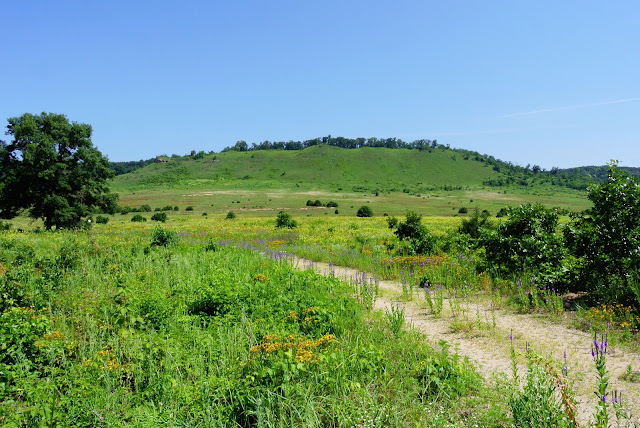 |
| Peter, Lisa, Kyle and Lindsey. Lindsey is happily making her way through clouds of mosquitoes. |
I took the opportunity before other friends arrived to investigate the bug life on the banks of the Wisconsin River. I was specifically interested in what tiger beetles I might find. Several Bronzed Tiger Beetles were scurrying across the sand in the afternoon sun. This was the only species I observed.
A well-caumouflaged Wolf Spider(Arctosa sp.) occupied my interest for several minutes.
 |
| Bronzed Tiger Beetle |
A well-caumouflaged Wolf Spider(Arctosa sp.) occupied my interest for several minutes.
I also observed several Blue-fronted Dancer damselflies and a Midland Clubtail dragonfly.
 |
| Midland Clubtail Dragonfly |
 |
| Blue-fronted Dancer |
As the sun was setting the mosquitoes became exponentially worse by the minute. Refusing Deet and opting for my natural bug spray, I paid the price with any exposed skin, mostly my hands and face, getting mutilated repeatedly by mosquitoes. Our friends, Kyle and Lisa, who only came out for the afternoon and early eve, were finally driven away by the massing blood thirsty mosquitoes as dusk came upon us. The remaining four of us, Lindsey, Corey, Peter and myself braved the swarms for several additional hours into the late evening. Corey, who also abstained from Deet, demonstrated his mosquito thwarting method (pictured below). However, I imagine burying one's face against the ground can only be endured for so long.
 |
| Corey in his mosquito thwarting position. |
 |
| Moon rising over the Wisconsin River |
 |
| Moonrise at civil twilight |
Around the 10 o'clock hour, we were treated to a calling Eastern Whip-Poor-Will across the river in neighboring Dane county. A Dane county lifer for me and year bird for Lindsey.
 In the morning we woke to the continued fierce swarm of mosquitoes. My mosquito ravaged skin felt some relief during a brief swim in the Wisconsin River. Following our morning swim, we hurriedly broke down camp and retreated to our mosquito free cars to head toward home, but not before we took some time to admire a millipede that Lindsey found.
In the morning we woke to the continued fierce swarm of mosquitoes. My mosquito ravaged skin felt some relief during a brief swim in the Wisconsin River. Following our morning swim, we hurriedly broke down camp and retreated to our mosquito free cars to head toward home, but not before we took some time to admire a millipede that Lindsey found.After the whole mosquito ordeal, I decided I needed to stop in Middleton at the Craftsman Table and Tap for a soul-soothing Bloody Mary over brunch.
 |
| Brunch of champions! |
Canada Geese
Mallard
Great Blue Heron
Sandhill Crane
Killdeer
Spotted Sandpiper
Solitary Sandpiper (seen by others)
Ring-billed Gull
Mourning Dove
Eastern Whip-poor-will
Belted Kingfisher
Red-headed Woodpecker (seen by others)
Red-bellied Woodpecker
Yellow-bellied Sapsucker
Yellow-bellied Sapsucker
Downy Woodpecker
Hairy Woodpecker
Northern Flicker
Eastern Wood-Pewee
Eastern Phoebe
Great Crested Flycatcher
Great Crested Flycatcher
Eastern Kingbird
Blue Jay
American Crow
Tree Swallow
Barn Swallow
Black-capped Chickadee
White-breasted Nuthatch
House Wren
Barn Swallow
Black-capped Chickadee
White-breasted Nuthatch
House Wren
Eastern Bluebird
Wood Thrush
American Robin
Cedar Waxwings
Ovenbird
Ovenbird
Eastern Towhee
Chipping Sparrow
Northern Cardinal
Rose-breasted Grosbeak
Indigo Bunting
American Goldfinch




























